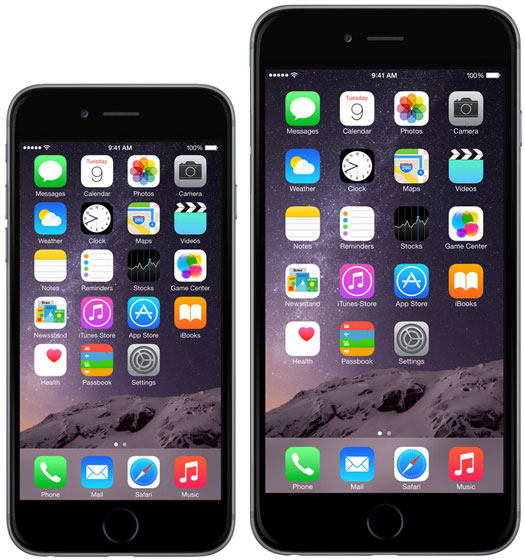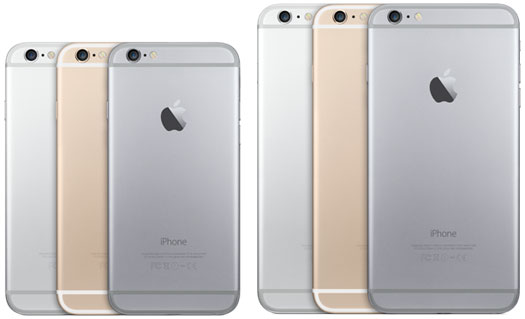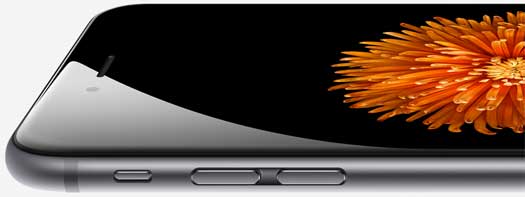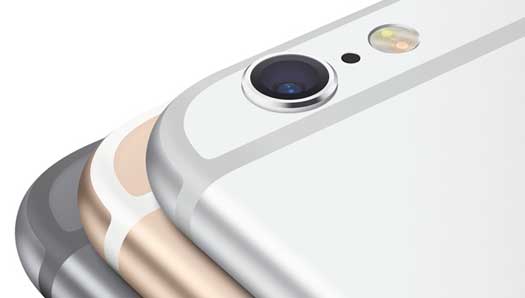Hosted by site sponsor WebMate.
iPhone Q&A
Update Published November 11, 2020
All Apple Q&As >> iPhone Q&A (Home)
To be notified of new Q&As, sign up for EveryMac.com's bimonthly email list.
What are all the differences between the iPhone 6 and the iPhone 6 Plus models? Which should I buy?
Please note that the iPhone 6 and iPhone 6 Plus have been discontinued. This Q&A has been updated with the latest iOS support details and more and can be quite helpful for anyone considering one of these models on the used market.
With even a casual glance at an iPhone 6 and iPhone 6 Plus side-by-side, it is obvious that the iPhone 6 Plus is larger and has a correspondingly larger display.
Of course, these casual observations are correct, but there also are a number of other important differences that are not so obvious.
Additionally, it is worth noting that there actually are eight distinct iPhone 6 and iPhone 6 Plus models (four of each) and EveryiPhone.com has meticulously documented each one as always. This Q&A primarily details collective differences for simplicity's sake.

Photo Credit: Apple, Inc.
(iPhone 6 Front - Left, iPhone 6 Plus Front - Right)
External Differences & Similarities
Both the iPhone 6 and iPhone 6 Plus use thin aluminum case designs with the front dominated by the display.
The displays are different, but they vary by more than the physical dimensions -- 4.7" (1334x750) for the iPhone 6 and 5.5" (1920x1080) for the iPhone 6 Plus. Both screens are multitouch capable, have IPS technology, are LED-backlit and have a 500 cd/m2 typical maximum brightness as well as "dual-domain pixels" for a wider viewing angle.
However, the iPhone 6 has a superior 1400:1 contrast ratio compared to 1300:1 for the iPhone 6 Plus. The iPhone 6 Plus, on the other hand, has a higher pixel density, 401 ppi compared to 326 ppi for the iPhone 6. In practice, these differences are minor -- and only those with extremely sharp vision will be able to differentiate the higher pixel density of the iPhone 6 Plus -- but it is worth noting that the iPhone 6 Plus display is true "HD" (1920x1080), whereas the iPhone 6 display is not despite Apple's identical "Retina HD" branding for the display in both models.

Photo Credit: Apple, Inc. (iPhone 6 Back - Left, iPhone 6 Plus Back - Right)
Each device is available in three color options -- silver, which has a white glass front and a silver colored aluminum back; gold, which has a white glass front and a gold colored aluminum back; and "space" gray, which has a black glass front and a gray aluminum back.
Apple initially discontinued the gold option on September 9, 2015, but continued to sell the silver and gray options until September 7, 2016. In February and March 2017, Apple re-introduced a 32 GB variant in gold in China and Taiwan and in Space Gray in the US, India, Europe, and other markets. These re-introduced models were once again discontinued on September 12, 2018.
Android fans might also note that the back looks a bit similar to models in the previously released, and generally well regarded, HTC One line, as well. The overall industrial design of the iPhone 6 and iPhone 6 Plus is similar to Apple's earlier iPod touch 5th Gen, with gently rounded sides, but the iPod touch has an entirely flat display whereas the iPhone 6 and iPhone 6 Plus have glass displays that themselves curve toward the also rounded sides for a "completely smooth and continuous surface."

Photo Credit: Apple, Inc. (iPhone 6/6 Plus - Curved Display Edge & Rounded Sides)
Both the iPhone 6 and iPhone 6 Plus additionally have an embedded "Touch ID" fingerprint sensor in the home button that allows for biometric identification rather than a mere passcode, a bottom mounted headphone jack, microphone, Lighting connector, and a single built-in speaker as well as an on/off switch on the righthand side.
Durability Differences
When these models first were released, the blogosphere was quite obsessed with the potential "bendability" of the iPhone 6 and iPhone 6 Plus. The respected Consumer Reports scientifically determined that it requires a significant 70 pounds of pressure to bend the iPhone 6 and 90 pounds of pressure to bend the iPhone 6 Plus when the pressure is placed horizontally across the middle of each device.
It might be a bit surprising that the iPhone 6 Plus is stronger than the iPhone 6, given its larger surface area. However, the iPhone 6 Plus is slightly thicker -- 7.1 mm rather than 6.9 mm -- and this extra thickness no doubt provides a bit of extra strength, again, at least when the pressure is placed horizontally across the middle of each device.
Based on hands-on evaluation, EveryiPhone.com also has found that the thinness, rounded edges, and the fairly slick finish combine to make the iPhone 6 and iPhone 6 Plus rather easy to drop, too. For those with smaller hands, the iPhone 6 Plus, in particular, is quite easy to drop when trying to reach across the display with one's thumb while simultaneously holding the device in the same hand. Consequently, a case is highly recommended to reduce the risk of damaging either device.
Of course, if you are concerned about accidentally bending the iPhone 6 or iPhone 6 Plus -- whether due to potential structural weakness or rough handling, either one -- a sturdy case would provide overall protection, too. Regardless, do not sit on your iPhone!
Camera Differences
The iPhone 6 and iPhone 6 Plus both have an identical FaceTime HD camera on the front of the device, but the rear iSight cameras have one important difference.
Both front-facing FaceTime HD cameras have a 1.2 megapixel sensor (1280x960), an f/2.2 aperture, and are capable of recording 720p video.
The rear-mounted iSight camera on both devices has an 8 megapixel sensor with 1.5µm pixels, an f/2.2 aperture, and is capable of recording 1080p video at 30 fps or 60 fps (as well as 240 fps for slo-mo). They also have a new sensor "featuring Focus Pixels for faster autofocus" and continuous autofocus and cinematic video stabilization.
Both also have a five-element lens and a dual LED "True Tone" flash, but the iPhone 6 Plus adds optical image stabilization, which uses the gyroscope to accommodate for shaky hands. Consequently, the iPhone 6 Plus camera provides slightly less "wiggly" video and much better low light photos compared to the standard iPhone 6.
For those interested in minor details, the rear camera in both the iPhone 6 and iPhone 6 Plus protrudes slightly from the housing just as it does on the previously released iPod touch 5th Gen. Although some armchair commentators have gone as far as referring to this protrusion as "appalling" and others even have speculated as to why Apple apparently attempted to hide the camera bump altogether in some product photos, this is unlikely to be an issue for all but the most fastidious.

Photo Credit: Apple, Inc. (iPhone 6/6 Plus Rear Camera)
However, it is worth noting that the camera "bump" means that the device will not sit entirely flat when placed on a table top if it is not held in a protective case.
Identification Differences
It is easy to differentiate between the iPhone 6 and the iPhone 6 Plus when the two devices are side-by-side.
However, for those who may not be able to readily estimate the size of a 4.7" or 5.5" display or who are not familiar with the dimensions of each device altogether, even collective visual identification can be difficult.
Many of the devices can be identified by Model Number, which is listed on the back of each iPhone in tiny type, but unfortunately not all can be individually identified in this way, either.
Nevertheless, the model numbers for each iPhone 6 and iPhone 6 Plus are:
iPhone |
Model Number |
As is clear from the above, model numbers A1549 and A1522 (in italics), for the iPhone 6 and iPhone 6 Plus, respectively, do not correspond to a single device. For the purpose of this Q&A, it is adequate to merely note that A1549 refers to an iPhone 6 and A1522 refers to an iPhone 6 Plus.
However, if you need to uniquely identify one of these iPhone 6 or iPhone 6 Plus models, they also can be pinpointed by other identifiers.
Specifically, EveryiPhone.com's Ultimate iLookup feature can precisely identify these iPhone models by Order Number (referred to as "Model" within the iOS "Settings" app under General > About), and their Serial Numbers, as well.
Battery Life Differences
With a physically larger display and corresponding housing, Apple took full advantage of the additional space in the iPhone 6 Plus and packed it with a higher capacity battery than the iPhone 6. In the site's customary teardown, iFixit discovered that the iPhone 6 has a 1810 mAh, 6.91 watt-hour battery whereas the iPhone 6 Plus has a 2915 mAh, 11.1 watt-hour battery.
As one would expect given the roughly 60% higher watt-hour rating, the iPhone 6 Plus provides significantly better battery life than the iPhone 6:
| iPhone 6 | iPhone 6 Plus | |
| Talk Time (3G) | 14 Hours | 24 Hours |
| Internet Use (3G) | 10 Hours | 12 Hours |
| Internet Use (4G/LTE) | 10 Hours | 12 Hours |
| Internet Use (Wi-Fi) | 11 Hours | 12 Hours |
| HD Video Playback | 11 Hours | 14 Hours |
| Audio Playback | 50 Hours | 80 Hours |
The iPhone 6 Plus provides more standby time as well -- 16 days (384 hours) -- compared to just 10 days (250 hours) for its smaller contemporary.
Wireless Connectivity & Data Differences
All iPhone 6 and iPhone 6 Plus models support 802.11a/b/g/n/ac, and specifically 802.11ac with speeds up to 433 Mbps, as well as Bluetooth 4.0 and GSM/EDGE (850, 900, 1800, 1900 MHz).
Other connectivity varies accordingly:
| iPhone Model | Model No. |
UMTS/HSPA+ DC-HSDPA |
CDMA EV-DO |
TD-SCDMA | LTE Bands (4G) |
| 6 (GSM/North America) | A1549 | 850, 900, 1700/2100, 1900, 2100 MHz | Unofficial | None | 1, 2, 3, 4, 5, 7, 8, 13, 17, 18, 19, 20, 25, 26, 28, 29 |
| 6 (CDMA/Verizon) | A1549 | 850, 900, 1700/2100, 1900, 2100 MHz | 800, 1700/2100, 1900, 2100 MHz | None | 1, 2, 3, 4, 5, 7, 8, 13, 17, 18, 19, 20, 25, 26, 28, 29 |
| 6 (Global/Sprint) | A1586 | 850, 900, 1700/2100, 1900, 2100 MHz | 800, 1700/2100, 1900, 2100 MHz | 1900 (F), 2000 (A) | FDD-LTE (1, 2, 3, 4, 5, 7, 8, 13, 17, 18, 19, 20, 25, 26, 28, 29); TD-LTE (38, 39, 40, 41) |
| 6 (China Mobile) | A1589 | 850, 900, 1700/2100, 1900, 2100 MHz | None | 1900 (F), 2000 (A) | FDD-LTE (1, 2, 3, 4, 5, 7, 8, 13, 17, 18, 19, 20, 25, 26, 28, 29); TD-LTE (38, 39, 40, 41) |
| 6 Plus (GSM/North America) | A1522 | 850, 900, 1700/2100, 1900, 2100 MHz | Unofficial | None | 1, 2, 3, 4, 5, 7, 8, 13, 17, 18, 19, 20, 25, 26, 28, 29 |
| 6 Plus (CDMA/Verizon) | A1522 | 850, 900, 1700/2100, 1900, 2100 MHz | 800, 1700/2100, 1900, 2100 MHz | None | 1, 2, 3, 4, 5, 7, 8, 13, 17, 18, 19, 20, 25, 26, 28, 29 |
| 6 Plus (Global/Sprint) | A1524 | 850, 900, 1700/2100, 1900, 2100 MHz | 800, 1700/2100, 1900, 2100 MHz | 1900 (F), 2000 (A) | FDD-LTE (1, 2, 3, 4, 5, 7, 8, 13, 17, 18, 19, 20, 25, 26, 28, 29); TD-LTE (38, 39, 40, 41) |
| 6 Plus (China Mobile) | A1593 | 850, 900, 1700/2100, 1900, 2100 MHz | None | 1900 (F), 2000 (A) | FDD-LTE (1, 2, 3, 4, 5, 7, 8, 13, 17, 18, 19, 20, 25, 26, 28, 29); TD-LTE (38, 39, 40, 41) |
Note that the China Mobile iPhone 6 and iPhone 6 Plus models support the WCDMA flavor of UMTS on the same frequencies as the other models as well as the same selection of FDD-LTE and TD-LTE bands as the "global" devices, but UMTS and FDD-LTE formally are "only for international roaming" rather than for use within mainland China. No doubt clever hackers will figure out workarounds for mainland use, too.
Internal Differences & Similarities
From a specific parts standpoint, there are many internal differences between the iPhone 6 and the iPhone 6 Plus. As noted above, the displays, cameras, and batteries each are different, as are a variety of other internal components.
However, these devices also have a great deal in common internally. Both are powered by a dual core 1.4 GHz Apple A8 processor, have an M8 motion coprocessor that "continuously measures data from the [six-axis] accelerometer, compass, gyroscope, and a new barometer," and have 1 GB of RAM.
In a more detailed technical evaluation, Chipworks found that the Apple A8 formally is a 20 nm TSCM manufactured processor dubbed APL1011. Additional analysis from AnandTech determined that the graphics processor is a four core PowerVR GX6450.
Both the iPhone 6 and the iPhone 6 Plus originally were available with 16 GB, 64 GB, or 128 GB of storage, but the 128 GB options were discontinued on September 9, 2015. In February and March 2017, Apple re-introduced 32 GB variants of the iPhone 6, but not the iPhone 6 Plus.
Also note that the entry-level configurations have 16 GB of storage whereas the original mid-level offering is 64 GB. The exact pricing varied by market, but in the US, the mid-level configuration originally provided 300% more storage for 50% more money.
Both devices also have an NFC (Near Field Communication) chip to allow digital payments in conjunction with "Apple Pay" software, too.
iOS Support Similarities
The iPhone 6 and iPhone 6 Plus both originally shipped pre-installed with iOS 8 and subsequently shipped with iOS 9. Both lines provide full support for the operating system including Apple Pay. They are supported by iOS 10, iOS 11, and iOS 12, too.
However, the iPhone 6 and iPhone 6 Plus models do not support iOS 13 or later versions of the iOS, including the current version.
iPhone 6 & iPhone 6 Plus Comparison Chart
These differences -- displays, durability, cameras, battery life, identifiers, and dimensions -- as well as other details and pricing information are summarized below:
 iPhone 6 |
 iPhone 6 Plus |
|
|---|---|---|
| Display Size: | 4.7" | 5.5" |
| Display Resolution: | 1334x750 | 1920x1080 |
| Pixel Density: | 326 ppi | 401 ppi |
| Contrast Ratio: | 1400:1 | 1300:1 |
| Bend Pressure: | 70 Pounds | 90 Pounds |
| Front Camera: | 1.2 Megapixels | 1.2 Megapixels |
| Rear Camera: | 8 Megapixels | 8 Megapixels |
| Cinematic Video Stabilization: | Yes | Yes |
| Continuous Autofocus Video: | Yes | Yes |
| Optical Image Stabilization: | No | Yes |
| Storage Options: | 16, 32, 64, 128 GB | 16, 64, 128 GB |
| Talk Time (3G): | 14 Hours | 24 Hours |
| 3G Battery Life: | 10 Hours | 12 Hours |
| 4G Battery Life: | 10 Hours | 12 Hours |
| Wi-Fi Battery Life: | 11 Hours | 12 Hours |
| Video Playback: | 11 Hours | 14 Hours |
| Audio Playback: | 50 Hours | 80 Hours |
| Standby Time: | 250 Hours | 384 Hours |
| Connector Type: | Lightning | Lightning |
| SIM Card: | Nano | Nano |
| Apple Pay (NFC): | Yes | Yes |
| Touch ID: | Yes | Yes |
| Dimensions: | 5.44 x 2.64 x 0.27* | 6.22 x 3.06 x 0.28* |
| Weight: | 4.55 oz. (129 g) | 6.07 oz. (172 g) |
| Model No: | A1549/A1586/A1589 |
A1522/A1524/A1593 |
| Intro. Price (US): | US$199, US$299, US$399† | US$299, US$399, US$499† |
* In inches, height x width x depth.
† These prices require a two-year contract in the US. Unlocked and contract free models are available at a premium.
So, should I buy an iPhone 6 or iPhone 6 Plus? Which is best for me?
For those not on the tightest of budgets, the newer iPhone 6s and iPhone 6s Plus, iPhone 7 or iPhone 7 Plus, iPhone 8 or iPhone 8 Plus, or even newer models are a better choice than either the iPhone 6 or iPhone 6 Plus. The newer devices have a case that is stronger and less likely to bend, stronger displays with more advanced 3D touch capability, faster performance, better cameras, more advanced connectivity, more recent iOS support, and more. The lack of current iOS support for the iPhone 6/iPhone 6 Plus means that app support will start to taper off going forward.
However, for those on a tight budget, the iPhone 6 and iPhone 6 Plus remain well worth consideration. For someone considering only the iPhone 6 and iPhone 6 Plus, rather than newer models, the size difference alone is enough to decide between them for most users.
The iPhone 6 is noticeably larger than all earlier iPhone models, but still works well for one-handed use for most people. The iPhone 6 Plus, by contrast, really is too large for many people to use easily with one hand and may be too large to fit comfortably, if at all, in the pockets in many pairs of pants.
Of course, if you place more importance on a large display for reading text, watching video, or gaming; tend to prefer to carry your mobile in a bag or purse rather than in your pockets; and you are willing to use your mobile in landscape (horizontal) mode with two hands much of the time, perhaps you would prefer the larger iPhone 6 Plus.
Among reviewers, the well respected John Gruber found the iPhone 6 size to be generally more usable than the iPhone 6 Plus, whereas the also well respected Terry White found the iPhone 6 Plus ideal for his large hands. Of course, the only opinion that truly matters for you is your own.
Apple's "Reachability" software tweak for the iOS helps those with smaller hands make the most of the iPhone 6 and iPhone 6 Plus by temporarily moving buttons closer to your fingers, but the smaller iPhone models still are easier to reach across for most people. If at all possible, EveryiPhone.com would strongly recommend thinking about whether reading and video are more important to you than one-handed usability and how you prefer to carry the device. Then, handle both devices in person prior to purchase to make the best decision for you.
For those who see advantages and disadvantages to both sizes and their displays, the optical image stabilization and longer battery life may be enough to convince you to go with the larger iPhone 6 Plus even if it means potentially less convenient usage and more awkward pocketability in addition to a higher upfront price.
On the other hand, if an even smaller mobile is desirable and/or an even lower price is important -- but display size, camera quality, battery life, and NFC payment capability (Apple Pay) are less important -- you might prefer a more compact and less expensive iPhone 5, Phone 5c or iPhone 5s or more compact and more powerful iPhone SE.
iPhone Purchase & Sale Options
There are many places to buy a new or used iPhone. However, buying your iPhone from a good company with an excellent reputation -- and quality after sales support -- will provide the ideal experience and save you money and time, too.
In the US, site sponsor Other World Computing sells used and refurbished iPhone models with free shipping. On the other hand, if you need to sell an iPhone, A+ BBB-rated Cash for Your Mac and GoRoostr will buy your older iPhone with an instant quote and prompt payment.
Please also see EveryiPhone.com's Ultimate iComparison feature to dynamically compare any iPhone model to any other iPod, iPhone, or iPad.
Also see:
Permalink | Report an Error/Typo | Sign Up for Site Update Notices
<< iPhone Q&A (Main) | All Apple Q&As
Established in 1996, EveryMac.com has been created by experts with decades of experience with Apple hardware. EveryMac.com includes, and always has included, original research incorporating detailed, hands-on inspection of packaging, computers, and devices as well as extensive real-world use. All information is provided in good faith, but no website or person is perfect. Accordingly, EveryMac.com is provided "as is" without warranty of any kind whatsoever. EveryMac.com, and the authors thereof, shall not be held responsible or liable, under any circumstances, for any damages resulting from the use or inability to use the information within. For complete disclaimer and copyright information please read and understand the Terms of Use and the Privacy Policy before using EveryMac.com. Copying, scraping, or use of any content without expressed permission is not allowed, although links to any page are welcomed and appreciated.
